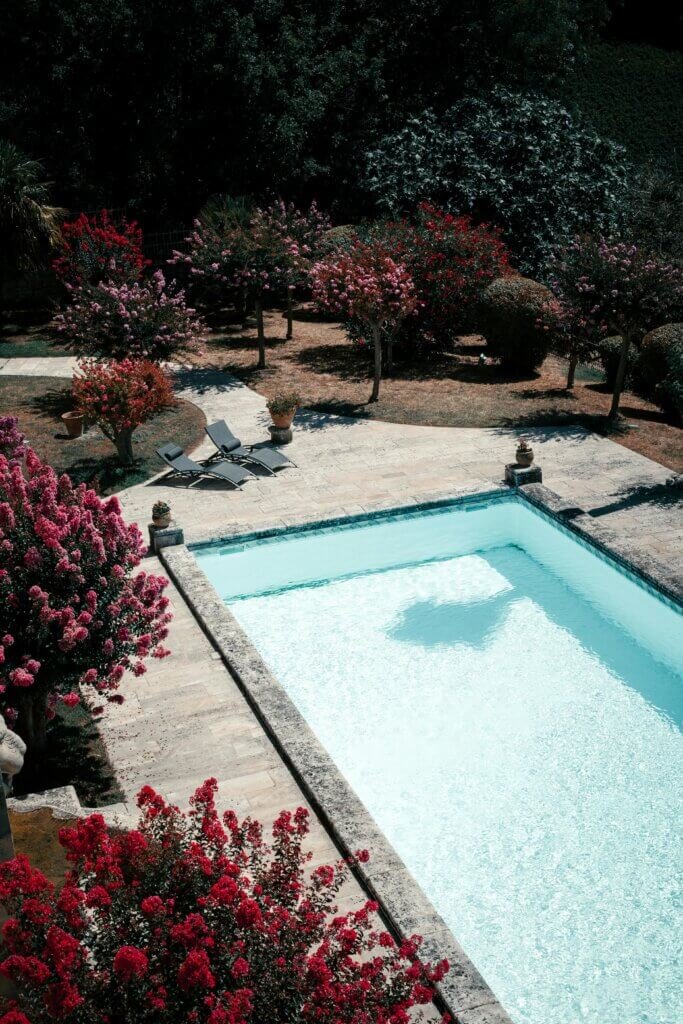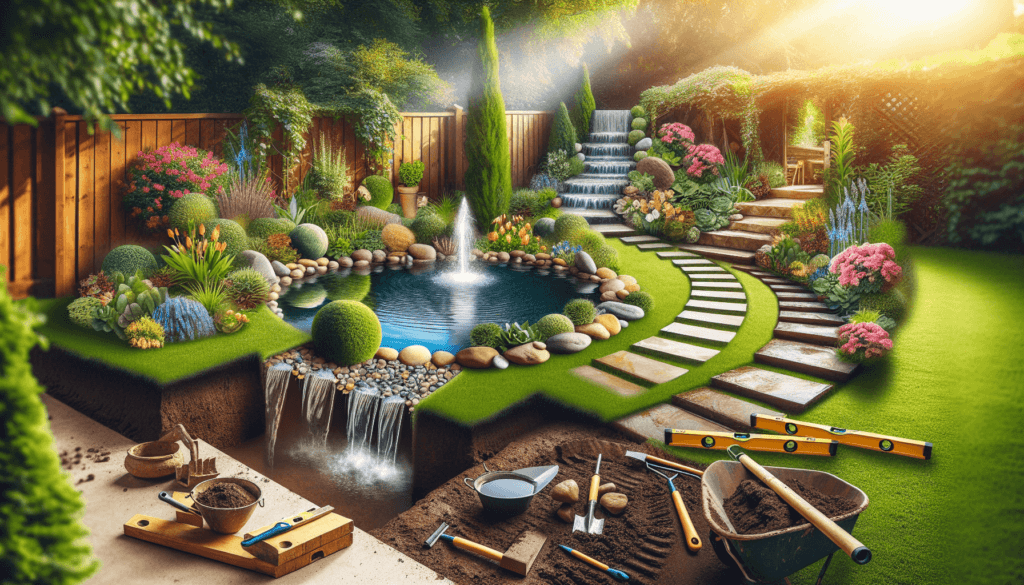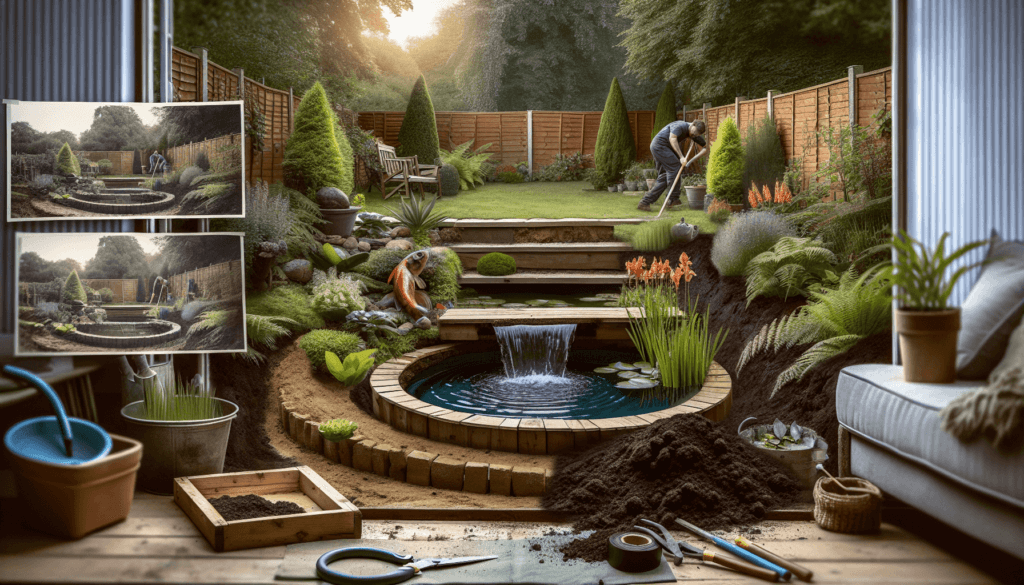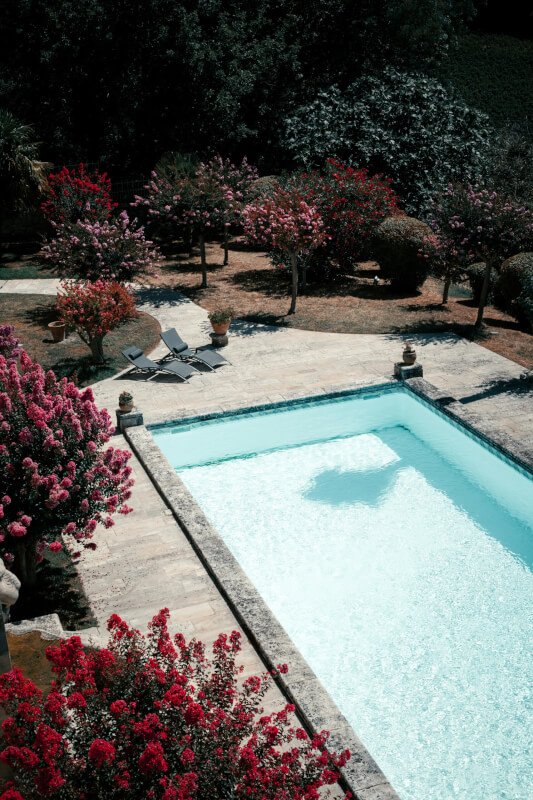If you’ve always dreamed of having a serene water feature in your garden, then our DIY guide to constructing a raised garden pond with a water feature is just what you need. Transform your outdoor space into a tranquil oasis with the simple and affordable steps outlined in this guide. Whether you’re a beginner or a seasoned DIY enthusiast, this article will help you bring your vision to life and create a stunning focal point that will wow your friends and family. So grab your tools and let’s get started on this exciting project that will elevate your garden to the next level of beauty and relaxation.

Choosing the Location
Determining the purpose of your pond
Before starting the construction of your garden pond with a water feature, it’s essential to determine its purpose. Are you looking to create a peaceful oasis for relaxation or a vibrant habitat for fish and wildlife? Understanding the purpose of your pond will help you make informed decisions throughout the construction process.
Considering sunlight and shade
When choosing the location for your garden pond, take into account the amount of sunlight and shade the area receives. Most aquatic plants require at least six hours of direct sunlight each day, so it’s important to choose a spot that meets these requirements. However, some shade can be beneficial to prevent excessive algae growth. Find a balance that suits the type of plants and aquatic life you wish to incorporate into your pond.
Checking for underground utilities
Before breaking ground, it’s crucial to check for any underground utilities. Contact your local utility companies to mark the location of gas, water, electrical, and cable lines. This will prevent any accidents or disruptions during excavation and construction.
Considering proximity to water source
An accessible water source is necessary for filling and maintaining your garden pond. Consider the proximity of your chosen location to a water source, such as a hose or outdoor faucet. You’ll want to ensure that it’s convenient to refill your pond and perform routine maintenance tasks.
Ensuring proper drainage
Proper drainage is crucial for maintaining the health and stability of your garden pond. You want to avoid any runoff or flooding that could damage the surrounding area or cause water quality issues. Choose a location with natural sloping or plan for a drainage system to prevent water from accumulating excessively.
Designing the Pond
Deciding on the size and shape
The size and shape of your garden pond will largely depend on your available space and personal preference. Consider the area’s dimensions and envision the shape that would complement your garden best. Keep in mind that larger ponds tend to have more stable and balanced water conditions.
Mapping out the pond
Take the time to map out the pond’s perimeter using stakes and string. This will give you a visual representation of the pond’s shape and enable you to make any necessary adjustments before moving forward. Ensure the boundaries align with your vision and consider how it will interact with surrounding features, such as raised garden beds or pathways.
Determining the depth
Determining the depth of your pond is important as it impacts both the aesthetics and the life it can support. Shallow areas ranging from six inches to two feet are ideal for aquatic plants, while deeper sections provide a habitat for fish and other aquatic life. Consider the types of plants and animals you wish to introduce to your pond when determining the depth.
Choosing the right materials
When designing your pond, it’s essential to select materials that are durable and suitable for aquatic environments. Opt for materials such as stone, brick, or concrete blocks for constructing the walls of your pond. Additionally, ensure any decorative elements, such as rocks or boulders, are safe for aquatic life and resistant to weathering.
Selecting a suitable liner
A high-quality liner is crucial for preventing water leakage and maintaining the overall health of your garden pond. Choose a liner that is specifically designed for pond use and consider factors such as durability, flexibility, and resistance to ultraviolet (UV) rays. Popular options include EPDM rubber liners or PVC liners if you prefer a more cost-effective alternative.
Preparing the Area
Clearing the chosen site
Before construction can begin, it’s important to clear the chosen site of any vegetation, rocks, or debris. Remove weeds, grass, and any other plants that could compromise the stability or aesthetics of your future garden pond. Rake the area to ensure it is clear and ready for leveling.
Leveling the ground
Leveling the ground is crucial for creating a stable and aesthetically pleasing foundation for your garden pond. Use a leveling tool, such as a long board or a laser level, to ensure the ground is even. Make any necessary adjustments by adding or removing soil until the area is perfectly level.
Creating a border
Creating a border around your pond not only adds to the visual appeal but also helps contain the water and prevent soil erosion. You can use various materials, such as stones, bricks, or timber, to create a border that matches your desired aesthetic. Ensure the border is sturdy and secure to withstand the weight of the water and any foot traffic.
Excavating the pond area
Excavation is a critical step in the construction process as it determines the size and depth of your garden pond. Using a shovel or a small excavator, carefully dig out the marked area, removing soil to achieve the desired depth. Take your time to ensure the walls are smooth and even, as this will make installation of the liner easier and prevent future issues.
Removing rocks and debris
During the excavation process, it’s essential to remove any rocks, roots, or other debris that may interfere with the construction or maintenance of your garden pond. These objects can puncture the liner, obstruct drainage, or create potential safety hazards. Be thorough in your removal to create a clean canvas for the next stages of the construction process.
Installing the Water Feature
Selecting the type of water feature
Before installing the water feature, consider the type that best suits your desired ambiance and maintenance requirements. Options range from simple bubbling fountains to intricate waterfalls or even a small stream. Research different types, designs, and the associated maintenance to choose one that aligns with your preference and skill level.
Determining the position within the pond
The placement of your water feature within the pond can significantly impact the overall aesthetics and functionality. Consider the sight lines from different angles and ensure the water feature is visible and easily appreciated from various viewpoints. Additionally, take into account any potential interaction with aquatic plants or fish to create a harmonious landscape.
Installing pumps and filters
Installing pumps and filters is essential for maintaining the water quality of your garden pond. These components help circulate and filter the water, keeping it clean and healthy for your aquatic plants and fish. Follow the manufacturer’s instructions for installation, and ensure the equipment is properly sized for your pond’s dimensions.
Connecting the water feature to a power source
To operate the pumps, filters, and any lighting elements, you’ll need to connect the water feature to a power source. Ensure you have a properly grounded outdoor electrical outlet or work with a qualified electrician to install one. It’s crucial to prioritize safety when dealing with electricity to avoid any accidents or damage to your pond and surrounding areas.
Adding decorative elements
To enhance the visual appeal of your water feature, consider adding decorative elements such as floating plants, rocks, or statuary. These elements can create depth, texture, and focal points within your garden pond. However, be mindful of the balance and scale to avoid overcrowding or overwhelming the overall design.

Building the Raised Garden Beds
Choosing the height and dimensions
When building raised garden beds, it’s crucial to consider the height and dimensions that will suit your gardening needs. The height can range from one to three feet, depending on factors such as accessibility, desired plant varieties, and personal preferences. Determine the appropriate dimensions based on the available space and the specific plants you plan to grow.
Constructing the garden bed frames
Constructing the frames for your raised garden beds can be done using various materials, such as wood, bricks, or concrete blocks. Choose materials that are durable, weather-resistant, and safe for growing edibles. Build the frames in the desired shape and size, ensuring they are level and secure.
Filling the beds with soil
Once the frames are in place, it’s time to fill the raised garden beds with soil. Use a high-quality garden soil or a mixture of compost, topsoil, and organic matter. Fill the beds evenly, ensuring there are no air pockets, and tamp down the soil gently to create a firm planting surface.
Adding compost and organic matter
To provide your plants with essential nutrients and promote healthy growth, incorporate compost and organic matter into the soil of your raised garden beds. These additions enhance soil fertility, moisture retention, and drainage. Spread a layer of compost and organic matter over the soil surface and gently work it into the top few inches of soil.
Selecting appropriate plants
Choosing the right plants for your raised garden beds is key to a successful and thriving garden. Consider factors such as sunlight requirements, soil type, and available space. Opt for a mix of vegetables, herbs, and flowers to create an aesthetically pleasing and productive garden. Research the specific needs of each plant and group them accordingly for easy maintenance and care.
Laying the Pond Liner
Measuring and cutting the liner
Before laying the pond liner, accurately measure the dimensions of your pond to determine the size of liner needed. Ensure you have a liner that has ample excess to cover the sides and bottom of the pond adequately. Using sharp scissors or a utility knife, carefully cut the liner to the appropriate size, following the measurements taken.
Ensuring proper fit and coverage
When placing the liner into the pond, ensure it fits snugly against the walls and covers the bottom evenly. Smooth out any wrinkles or folds to prevent water leakage and create a visually appealing surface. Take your time to ensure the liner is not stretched too tight, as this can lead to tearing or displacement over time.
Securing the liner in place
To secure the liner in place, use heavy-duty stakes or rocks along the edges of the pond. Push the stakes or place the rocks strategically to prevent the liner from shifting or floating during the filling process. Be cautious not to damage the liner or create any punctures while securing it in place.
Trimming excess liner
Once the liner is securely in place, trim any excess material using sharp scissors or a utility knife. Leave a small overhang of a few inches to allow for settling and any adjustments needed during the filling process. Trim the liner neatly and as close to the ground level as possible for a clean and finished appearance.
Checking for leaks
Before proceeding with the next steps, fill the pond with water to check for any potential leaks in the liner. Allow the pond to fill to the desired level and carefully inspect the liner for any signs of water escaping. Address any leaks immediately by adjusting the liner or applying a patch, ensuring a watertight seal.

Filling and Testing the Pond
Filling the pond with water
With the liner in place and any necessary adjustments made, it’s time to fill your pond with water. Attach a hose or use a bucket to gradually fill the pond, allowing water to displace any trapped air beneath the liner. Fill the pond until it reaches the desired depth, taking care not to overfill it.
Adding water treatments
To establish a healthy and balanced ecosystem, consider adding water treatments to your pond. These treatments help condition the water, balance pH levels, and eliminate harmful chemicals, ensuring the well-being of aquatic plants and fish. Follow the manufacturer’s instructions for dosage and application frequency.
Monitoring water quality
After filling the pond and adding water treatments, it’s crucial to monitor the water quality regularly. Use a water testing kit to check parameters such as pH, ammonia, nitrite, and nitrate levels. Adjust as necessary to maintain a stable and healthy environment for your pond’s inhabitants.
Checking for leaks and adjusting levels
Once your pond is filled, continue to monitor for any signs of leaks or water loss. Check the water level daily for the first week, ensuring it remains consistent. If you notice any significant drops in water level, inspect the liner and connections for any signs of leakage. Make any necessary adjustments promptly to prevent further damage.
Introducing aquatic plants and fish
When the water quality is stable, it’s time to introduce aquatic plants and fish into your pond. Research the specific requirements of the plants and animals you plan to introduce, considering factors such as temperature tolerance, compatibility, and natural habitat preferences. Gradually acclimate them to the pond’s water to minimize stress.
Creating a Natural Look
Adding rocks and boulders
To create a natural and aesthetically pleasing look, add rocks and boulders around and within your garden pond. These natural elements enhance the visual appeal and provide various surfaces for plants to grow on. Consider the size, shape, and color of the rocks to create a balanced and harmonious design.
Planting around the pond
Planting around the pond adds depth, texture, and color to your garden landscape. Choose plants that thrive in moist environments and complement the overall aesthetic. Consider a mix of water-loving plants, such as water lilies or cattails, as well as bog plants and ornamental grasses. Place taller plants towards the back and gradually decrease height towards the front for optimal visibility.
Creating a waterfall or stream
If you desire the soothing sound of flowing water, consider incorporating a waterfall or stream into your pond design. This feature adds movement, visual interest, and the delightful sound of trickling water. Plan the watercourse strategically, ensuring it complements the surrounding landscape and directs water flow effectively.
Incorporating natural elements
To enhance the natural ambiance of your garden pond, incorporate additional elements such as driftwood, logs, or aquatic sculptures. These features add character and attract wildlife to your pond. Be mindful of the scale and ensure the additions blend seamlessly with the overall design.
Mulching and landscaping
Finish off the area surrounding your pond by mulching and landscaping. Use organic mulch, such as wood chips or bark, which not only adds a polished appearance but also helps retain moisture and suppress weed growth. Consider adding pathways, seating areas, or decorative borders to further enhance the visual appeal and functionality of your garden pond.

Maintenance and Care
Regular cleaning and debris removal
To ensure the long-term health and beauty of your garden pond, establish a regular cleaning and maintenance routine. Remove any debris, fallen leaves, or excess vegetation from the water surface and surrounding areas. Use a skimmer net or pond vacuum to keep the water clean and free from floating debris.
Monitoring water quality and pH levels
Regularly monitor the water quality and pH levels of your garden pond to maintain a healthy ecosystem. Test the water weekly or as recommended by the manufacturer’s instructions. Adjust the pH, ammonia, nitrite, and nitrate levels as necessary to prevent water quality issues and promote the well-being of your aquatic plants and fish.
Trimming and pruning plants
Over time, plants in and around your pond may require trimming and pruning to maintain their shape and promote healthy growth. Remove any dead or decaying foliage and trim back overgrown plants to prevent overcrowding. Be cautious when handling plants near the water to avoid disturbing the pond’s balance or causing unintentional damage to liners or equipment.
Winterizing the pond
In colder climates, it’s essential to winterize your garden pond to protect it from freezing temperatures. Begin by removing any water plants or fish that cannot survive the winter. Trim back plants to prevent damage from ice and snow loads. Consider installing a pond heater or using insulation blankets to prevent the water from freezing completely.
Troubleshooting common issues
Even with proper care, occasional issues may arise with your garden pond. Algae blooms, equipment malfunctions, or water quality imbalances can occur. It’s essential to troubleshoot these issues promptly to prevent further damage. Research common pond problems and solutions or consult with local pond specialists to address any issues effectively.
Enjoying Your Garden Pond
Adding seating and relaxation areas
Create inviting seating and relaxation areas near your garden pond to fully enjoy its beauty and tranquility. Place comfortable chairs, benches, or even a hammock strategically around the pond. Consider the best vantage points for enjoying the water feature and surrounding wildlife. Personalize the area with cushions, pillows, or shade structures for added comfort.
Installing outdoor lighting
Extend the enjoyment of your garden pond into the evening hours by installing outdoor lighting. Illuminate the water feature with underwater or floating lights to create a mesmerizing ambiance. Additionally, consider installing pathway lighting or accent lights to enhance safety and highlight key features of your garden landscape.
Welcoming wildlife
The presence of water attracts a variety of wildlife, adding a natural and dynamic element to your garden pond. Encourage the arrival of birds, butterflies, dragonflies, or frogs by incorporating plants, water features, and sheltering structures. Consider providing bird feeders or nesting boxes to invite even more wildlife diversity.
Creating a serene atmosphere
To fully enjoy your garden pond, create a serene atmosphere that enhances relaxation and peace. Incorporate elements such as wind chimes, gentle music, or even a small fountain to create soothing sounds. Surround the area with fragrant plants or herbs to elevate the sensory experience and promote a calming atmosphere.
Hosting small gatherings
Your enchanting garden pond provides an ideal setting for hosting small gatherings or intimate gatherings with family and friends. Arrange seating areas strategically to encourage conversation and connection. Add extra touches such as soft lighting, comfortable cushions, and a small outdoor bar to create a welcoming and memorable atmosphere.



